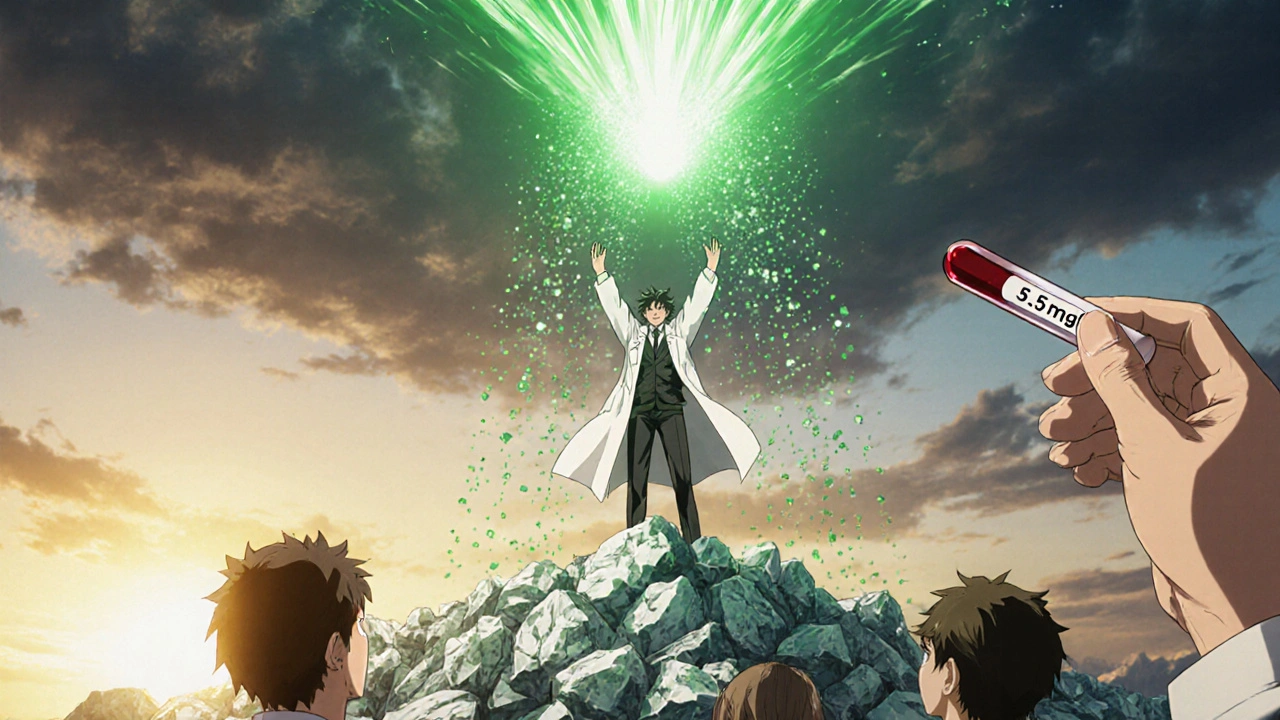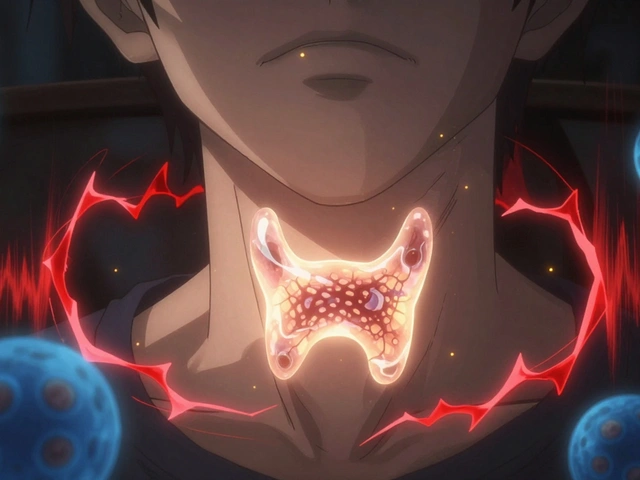When your big toe suddenly swells up, turns red, and feels like it’s on fire-especially after a night of beer and steak-you’re not just having bad luck. You’re experiencing gout, a painful form of arthritis caused by something happening deep inside your body: purine metabolism gone wrong.
It’s not about eating too much meat or drinking too much alcohol alone. Those things can trigger it, but the real problem starts with how your body breaks down purines-natural compounds found in your cells and in certain foods. When purines are broken down, they turn into uric acid. Normally, your kidneys flush it out. But if you make too much or your kidneys can’t keep up, uric acid builds up, forms sharp crystals in your joints, and triggers intense inflammation. That’s gout.
Why Your Body Makes Too Much Uric Acid
Humans are one of the few animals that don’t have an enzyme called uricase. About 15 to 20 million years ago, we lost it. That means uric acid is the final product of purine breakdown in our bodies. In most mammals, uricase turns it into allantoin, which is easy to excrete. In us? It just sits there.
Purines come from two places: your own cells (about 70%) and your diet (about 30%). Every time your cells die and renew, they release purines. That’s normal. But if your body makes too many purines-or if your kidneys don’t clear uric acid well-you end up with high levels in your blood. That’s called hyperuricemia.
The magic number is 6.8 mg/dL. That’s the point where uric acid starts to crystallize in your joints. Once levels hit 7.0 mg/dL or higher, your risk of gout jumps sharply. At 9.0 mg/dL, nearly 28% of people will develop gout. Most people don’t know they’re in this danger zone until they have their first flare.
How Purines Turn Into Uric Acid (The Biochemical Pathway)
It’s a step-by-step process:
- Nucleic acids (DNA and RNA) break down into nucleotides.
- Nucleotides become nucleosides like adenosine and guanosine.
- Adenosine turns into inosine, then hypoxanthine.
- Guanosine turns into guanine, then xanthine.
- Both hypoxanthine and xanthine are turned into uric acid by an enzyme called xanthine oxidase.
This is where most drugs step in. Xanthine oxidase is the final gatekeeper. Block it, and you block uric acid production.
Most of the uric acid your body makes (65%) leaves through your kidneys. But here’s the twist: 90% of the uric acid your kidneys filter gets reabsorbed back into your blood by transporters called URAT1 and GLUT9. So even if your kidneys are working fine, they’re basically holding onto most of the uric acid. That’s why some drugs don’t help your kidneys work harder-they help them stop reabsorbing so much.
The Three Types of Urate-Lowering Medications
There are three main classes of drugs used to lower uric acid long-term. Each works differently, and each has pros and cons.
1. Xanthine Oxidase Inhibitors (XOIs): Block Production
These are the first-line treatment for most people. They stop xanthine oxidase from making uric acid.
Allopurinol has been around since 1966. It’s cheap-generic versions cost about $4.27 a month. It works well, but only if you take enough. Many doctors start patients at 100 mg a day and never increase it. That’s a mistake. Studies show that 92% of people reach their target uric acid level when allopurinol is titrated up to 300 mg or higher. The problem? Side effects. About 42% of users report skin rashes, and 12% get severe ones. People with the HLA-B*58:01 gene variant are at higher risk, especially in Asian populations.
Febuxostat came along in 2009. It’s stronger than allopurinol and doesn’t need dose adjustments for kidney problems. At 80 mg a day, it hits target levels in 67% of patients. But in 2019, the FDA added a black box warning after a major study found more heart-related deaths with febuxostat than with allopurinol. It’s still used, but not for people with heart disease unless there’s no other option.
2. Uricosurics: Help Kidneys Flush It Out
These drugs block the URAT1 transporter, so your kidneys don’t reabsorb uric acid. They make your body excrete more.
Probenecid has been used since 1949. It’s affordable and works well if your kidneys are healthy (creatinine clearance above 50 mL/min). But if your kidneys are already damaged, it won’t help-and might even make things worse. It’s also less effective than XOIs, with only 40-50% of patients reaching target levels.
Lesinurad was approved in 2015 and combined with allopurinol to boost effectiveness. It pushed 54% of patients to target. But it was pulled from the market in 2019 because it caused serious kidney damage in some people. It’s a reminder: forcing your kidneys to work harder isn’t always safe.
3. Uricase Enzymes: Break Down Uric Acid Completely
These are the heavy hitters. They mimic the enzyme we lost millions of years ago.
Pegloticase is given as an IV infusion every two weeks. It turns uric acid into allantoin, which your body easily gets rid of. In trials, 42% of patients reached target levels within six months. For people with severe tophaceous gout-where uric acid crystals form visible lumps under the skin-it can dissolve them completely. One patient on Reddit said it took 17 insurance appeals to get coverage, but after nine months, his tophi vanished.
The catch? It costs about $16,429 a month. And 26% of people have severe infusion reactions. You need to be premedicated with steroids and antihistamines. It’s reserved for patients who’ve failed everything else.

What Really Happens When You Start Treatment
Here’s the irony: starting urate-lowering therapy can actually trigger gout flares. Why? Because as crystals start to dissolve, they release fragments that your immune system attacks. It’s like stirring up a hornet’s nest.
That’s why guidelines say: always start with a flare-prevention drug. Most doctors prescribe low-dose colchicine (0.6 mg once or twice daily) for at least six months after beginning allopurinol or febuxostat. Some wait until there are no flares for three months before stopping it.
But in real life? Only 29% of primary care doctors follow this. Most just hand out a prescription and say, “Take this daily.” Patients get flares, think the medicine isn’t working, and quit.
Why So Many People Stop Taking Their Medication
A 2022 survey found that 61% of gout patients stop their urate-lowering meds within a year. Why?
- 33% think it’s not working-because they still get flares early on.
- 29% have side effects-rash, liver changes, stomach upset.
- 18% say the dosing is too confusing.
And here’s the kicker: many patients don’t even know what their target uric acid level is. They’re told to take a pill every day, but no one tells them to get blood tests. You can’t manage gout without monitoring. The goal is to get uric acid below 6.0 mg/dL-and for severe cases, below 5.0 mg/dL. Without regular testing, you’re flying blind.

Diet Matters-But Not Like You Think
Yes, organ meats like liver have 240-400 mg of purines per 100 grams. Anchovies? 500 mg. Beer? Up to 20 grams of purines per liter.
But cutting out these foods alone only lowers uric acid by 1-2 mg/dL. That’s not enough to get most people to target. Diet helps, but it’s not the main tool. It’s a sidekick.
What really helps? Losing weight if you’re overweight. Cutting out sugary drinks. Avoiding alcohol, especially beer and spirits. Drinking plenty of water. These changes support your meds-but they don’t replace them.
The Future: What’s Coming Next
Researchers are working on better drugs. Verinurad, a new URAT1 blocker, is in Phase III trials. When combined with febuxostat, it pushed 74% of patients to target in 12 weeks. That’s huge.
Arhalofenate is another promising drug-it lowers uric acid AND reduces inflammation. In a 2024 trial, it cut flare frequency by 58% compared to placebo.
And then there’s personalized medicine. Scientists are looking at genes like SLC2A9 that affect how your kidneys handle uric acid. In the future, your genetic profile might tell your doctor which drug will work best for you-before you even start.
What You Need to Do Right Now
If you have gout:
- Don’t stop your medication because you had a flare. Talk to your doctor.
- Ask for a serum uric acid test every 2-5 weeks until your level is below 6.0 mg/dL.
- Make sure you’re on the right dose. Allopurinol at 100 mg is often too low.
- Ask about colchicine for the first six months to prevent flares.
- Track your diet and alcohol intake-but don’t blame yourself if flares still happen.
- If you’re on pegloticase, know your insurance hurdles. Get help from patient advocacy groups.
Gout isn’t just about pain. It’s a sign of deeper metabolic problems. Most people with gout also have high blood pressure, obesity, or kidney disease. Treating gout isn’t just about stopping flares-it’s about protecting your heart, kidneys, and overall health.
The good news? With the right medication, the right dose, and the right monitoring, gout can be controlled. Not just managed. Controlled. For good.
Can gout be cured with diet alone?
No. While diet can help lower uric acid by 1-2 mg/dL, most people need medication to reach the target level of below 6.0 mg/dL. Gout is caused by how your body processes purines, not just what you eat. Medication is necessary for long-term control.
Why do I still get flares after starting allopurinol?
That’s normal. As uric acid crystals dissolve, they release particles that trigger inflammation. This is called a "treatment flare." It doesn’t mean the drug isn’t working. Taking low-dose colchicine for at least six months while starting urate-lowering therapy can prevent this. Talk to your doctor if flares continue after six months.
Is febuxostat safer than allopurinol?
Not necessarily. Febuxostat is more effective at lowering uric acid, but the FDA issued a black box warning in 2019 after a study showed higher rates of heart-related deaths compared to allopurinol. It’s still used, but only for people who can’t tolerate allopurinol or have severe kidney disease. If you have heart disease, allopurinol is usually the safer choice.
How often should I get my uric acid levels checked?
Every 2 to 5 weeks until your level is below 6.0 mg/dL. Once you’re stable, check every 6 months. Most primary care doctors don’t do this regularly, so you may need to ask for it. Without testing, you can’t tell if your medication is working.
What happens if I stop taking my urate-lowering medication?
Your uric acid levels will rise again, and crystals will start forming in your joints once more. Flares will return, and over time, tophi (hard lumps of uric acid crystals) can develop in your joints, skin, and even kidneys. Gout is a chronic condition that requires ongoing treatment. Stopping medication means going back to the cycle of pain and damage.
Can I drink alcohol if I have gout?
Beer and spirits are the worst-they raise uric acid and reduce its excretion. Wine is less risky, but still not safe in large amounts. Even moderate drinking can trigger flares. The safest approach is to avoid alcohol entirely, especially during the first year of treatment. Once your uric acid is stable and you’ve had no flares for a year, occasional light wine may be okay-but check with your doctor first.





Just wanted to say this post is a game-changer. I’ve had gout for 5 years and no doctor ever explained the urate reabsorption part - now I get why my meds weren’t working. Started on 300mg allopurinol last month and my levels dropped from 9.2 to 5.8. Still got one flare, but I’m not panicking anymore. Keep sharing this stuff - people need to know it’s not just ‘eat less steak’.
It’s wild to think we lost uricase millions of years ago. Evolution didn’t care if we’d one day be drinking IPA and eating foie gras in a sedentary office. We’re biological ghosts of a metabolic past - our bodies still think we’re frugivores in a jungle, not humans chained to desks with kombucha and avocado toast. The irony? The very thing that gave us energy to survive now makes our toes scream when we celebrate a promotion with beer.
OMG THIS IS SO IMPORTANT!!! 🙌 I’m a rheumatology nurse and I can’t believe how many patients stop their meds after one flare!! 😭 The fact that 61% quit within a year?? That’s a SYSTEMIC FAILURE. We need mandatory uric acid testing protocols in primary care, like we do for cholesterol!! 📊 And PLEASE stop prescribing 100mg allopurinol like it’s a placebo!! 🚨 The HLA-B*58:01 screening in Asian populations is CRITICAL - why isn’t this standard?? I’ve seen so many rashes, so many avoidable hospitalizations… This post should be mandatory reading for every med student. #GoutAwareness #UrateLoweringIsNotOptional
Pegloticase costs $16k a month. That’s not treatment. That’s a luxury.
I’ve been on allopurinol for two years. My doctor never mentioned colchicine. I had three flares in the first four months and thought the drug was broken. Turns out I just needed the anti-inflammatory safety net. I wish I’d known sooner. Thanks for the clarity - I’m sharing this with my support group.
Of course the U.S. has the worst gout outcomes - we let Big Pharma decide what’s affordable. Allopurinol costs $4 a month, but they push febuxostat because it’s patented. And pegloticase? That’s not medicine - it’s a profit scheme for insurance companies to say ‘we tried everything.’ Meanwhile, real people are choosing between rent and their meds. This isn’t science - it’s capitalism with a stethoscope.
This is the most thoughtful breakdown of gout I’ve ever read. I’ve been telling my patients for years that diet alone won’t cut it, but nobody listens. The part about URAT1 reabsorption? That’s the missing link. I’m printing this out for my clinic. And to anyone reading this - don’t give up. It takes time. Your body isn’t broken. It’s just misunderstood. You’re not failing. The system is.
So let me get this straight - we have a drug that can dissolve tophi but costs more than a Tesla and requires IV infusions and steroid premeds... and we’re surprised people don’t take their $4 pill? 🤦♀️